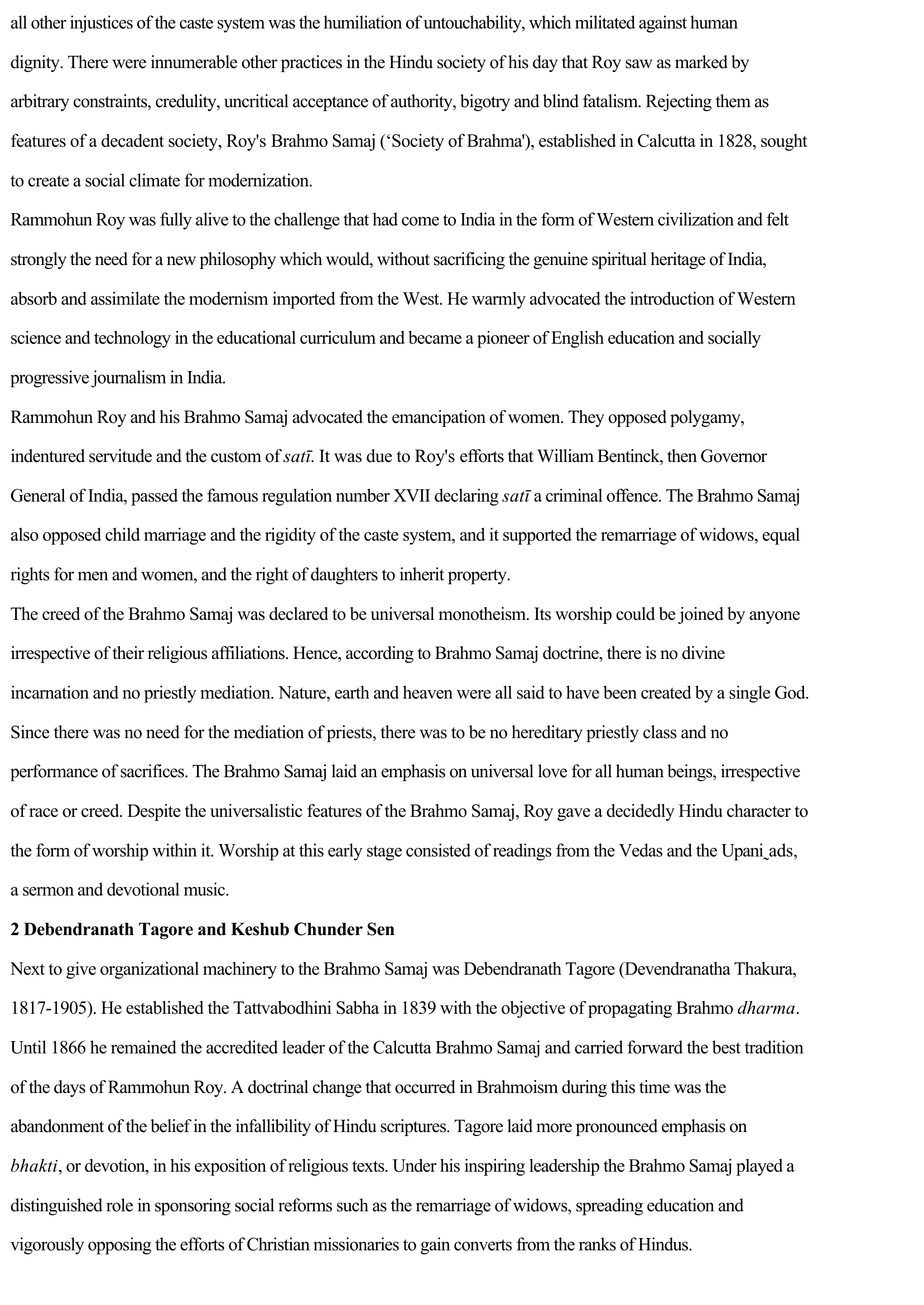Brahmo Samaj
Publié le 22/02/2012

Extrait du document
«
all other injustices of the caste system was the humiliation of untouchability, which militated against human
dignity.
There were innumerable other practices in the Hindu society of his day that Roy saw as marked by
arbitrary constraints, credulity, uncritical acceptance of authority, bigotry and blind fatalism.
Rejecting them as
features of a decadent society, Roy 's Brahmo Samaj ( ‘Society of Brahma' ), established in Calcutta in 1828, sought
to create a social climate for modernization.
Rammohun Roy was fully alive to the challenge that had come to India in the form of Western civilization and felt
strongly the need for a new philosophy which would, without sacrificing the genuine spiritual heritage of India,
absorb and assimilate the modernism imported from the West.
He warmly advocated the introduction of Western
science and technology in the educational curriculum and became a pioneer of English education and socially
progressive journalism in India.
Rammohun Roy and his Brahmo Samaj advocated the emancipation of women.
They opposed polygamy,
indentured servitude and the custom of satī .
It was due to Roy 's efforts that William Bentinck, then Governor
General of India, passed the famous regulation number XVII declaring satī a criminal offence.
The Brahmo Samaj
also opposed child marriage and the rigidity of the caste system, and it supported the remarriage of widows, equal
rights for men and women, and the right of daughters to inherit property.
The creed of the Brahmo Samaj was declared to be universal monotheism.
Its worship could be joined by anyone
irrespective of their religious affiliations.
Hence, according to Brahmo Samaj doctrine, there is no divine
incarnation and no priestly mediation.
Nature, earth and heaven were all said to have been created by a single God.
Since there was no need for the mediation of priests, there was to be no hereditary priestly class and no
performance of sacrifices.
The Brahmo Samaj laid an emphasis on universal love for all human beings, irrespective
of race or creed.
Despite the universalistic features of the Brahmo Samaj, Roy gave a decidedly Hindu character to
the form of worship within it.
Worship at this early stage consisted of readings from the Vedas and the Upani ˷ads ,
a sermon and devotional music.
2 Debendranath Tagore and Keshub Chunder Sen
Next to give organizational machinery to the Brahmo Samaj was Debendranath Tagore (Devendranatha Thakura,
1817-1905).
He established the Tattvabodhini Sabha in 1839 with the objective of propagating Brahmo dharma .
Until 1866 he remained the accredited leader of the Calcutta Brahmo Samaj and carried forward the best tradition
of the days of Rammohun Roy.
A doctrinal change that occurred in Brahmoism during this time was the
abandonment of the belief in the infallibility of Hindu scriptures.
Tagore laid more pronounced emphasis on
bhakti , or devotion, in his exposition of religious texts.
Under his inspiring leadership the Brahmo Samaj played a
distinguished role in sponsoring social reforms such as the remarriage of widows, spreading education and
vigorously opposing the efforts of Christian missionaries to gain converts from the ranks of Hindus..
»
↓↓↓ APERÇU DU DOCUMENT ↓↓↓
Liens utiles
- Ramakrishna Ramakrishna (1834-1886), brahmane bengali, l'un des principaux acteurs du renouveau indien au XIXe siècle avec Vivekananda, son disciple, et Dayananda Saravasti, fondateur du mouvement réformiste hindou Arya Samaj.
- Arya Samaj

































